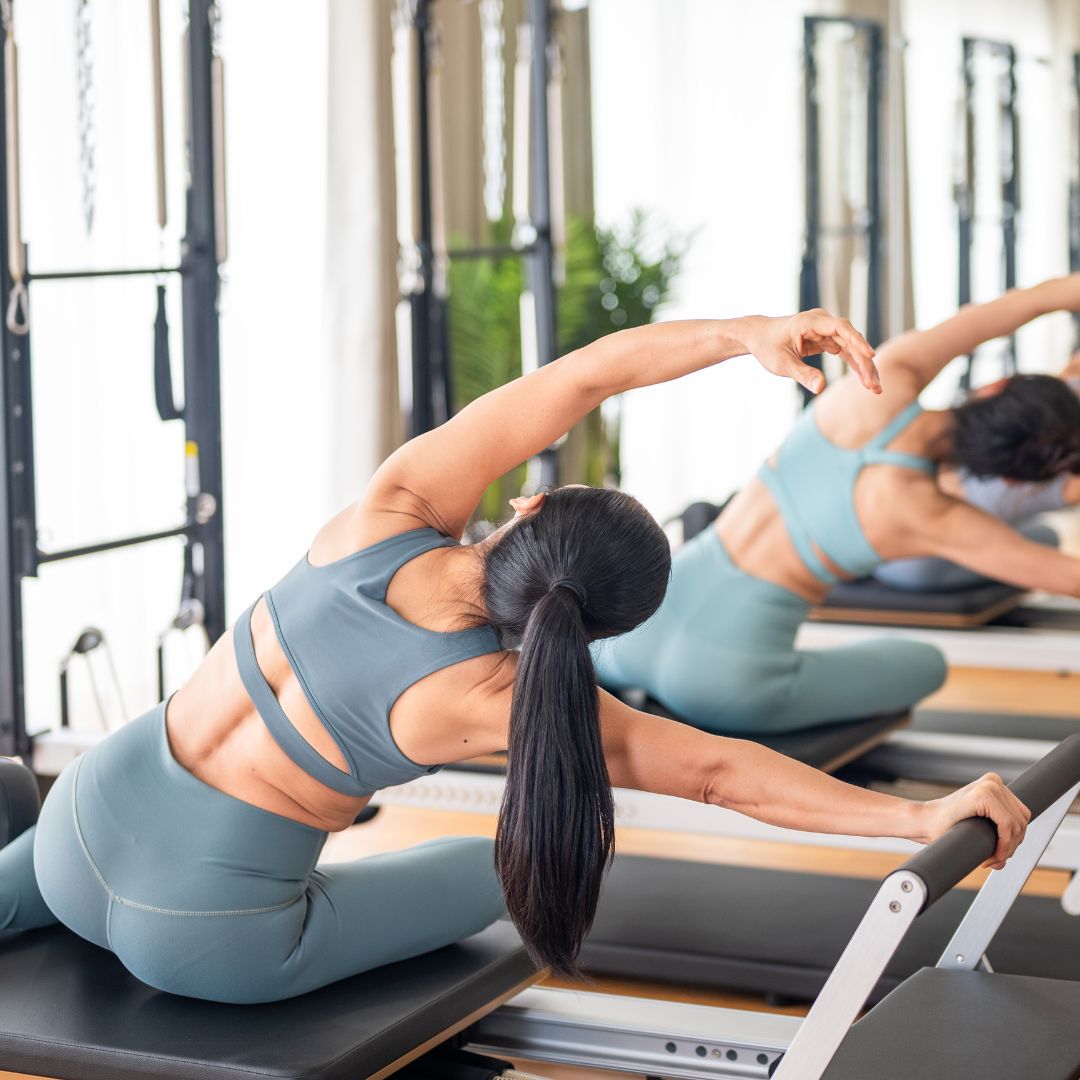
Reformer Pilates at home sounds impossible, right? Who here has room for an entire reformer machine in their living room (or could afford to buy one for that matter)? Nope, us neither.
But we love reformer Pilates for all the added strengthening benefits it adds to our regular Pilates workouts. Research shows that just twelve sessions of reformer Pilates lead to strength gains in the deep, stabilising muscles thanks to "the emphasis on core strength and stability, for which contraction of the deep extensor muscles of the spine is required." Compared to mat Pilates, reformer also improves oblique and abdominal strength to a greater extent, according to a 2017 paper.
If you've not managed to get to a reformer class yet, Pilates instructor Lottie Murphy explains that it is "just as rooted in the teachings of Joseph Pilates as mat Pilates. It involves exercising on a piece of apparatus know as the reformer which features a set of springs underneath a carriage. There’s also straps with loops which you might place your feet or hands into and then pull against to again challenge or even assist your movements."
If you have gone to a reformer class but are looking for a more affordable way to continue your love affair with the workout, we've got you. Murphy has shared her favourite ways to re-create reformer from home - just grab your mat.
Spoiler alert: There are a whole heap of benefits of Pilates on offer, whether you head in-studio or opt for a home session. Do scroll our guides to Pilates for beginners and a pro's selection of their go-to 20-minute Pilates workouts and best 30-minute Pilates workouts, while we've got you.
Reformer Pilates from home: your guide
What are the benefits of Reformer Pilates at home?
Short answer: There are a lot, as Murphy highlights below.
1. It provides extra resistance
"The extra resistance of the springs and carriage in reformer challenge balance, strength, stability and awareness," says Murphy. Indeed, working with equipment is a great way to up the intensity and continue to challenge your body to keep developing strength and mobility as you advance. From home, you won't be using springs and a bed, but you can recreate the same resistance using other types of kit.
2. It's more affordable
Reformer Pilates classes are one of the most expensive out there, so keeping up a regular practice is pretty unaffordable for most. Instead, you can supplement your in-person classes with reformer at home for a much more accessible way to train.
3. It improves mind-body connection
"Your body will really have to work as a whole to stabilise, even when isolating certain muscle groups, and it encourages the mind body connection that Pilates is well known for," says Murphy. Indeed, Pilates focuses on controlling movements to build strength - and when you add in extra resistance and instability as with reformer, you need to connect even deeper with the body to stabilise.
How to do reformer Pilates at home
The first important question is: is it really possible to do reformer at home without a carriage and springs?
"Most, if not all, of the Reformer exercises can be transferred and adapted to be performed on the mat - you just need small Pilates equipment," says Murphy. "While nothing can fully mimic the synchronised and integrated feeling of being on a reformer machine that is designed incredibly well to help you feel aligned and co-ordinated, it’s very fun and challenging to take your mat Pilates at home to another level by experiencing the reformer Pilates exercises on the mat."
She recommends using Therabands, which can act like reformer straps and add resistance while replicating moves such as legs in straps and rowing series, and gliders, which can give the sliding experience that the reformer carriage offers. Not to mention, you can use all the extra kit that sometimes comes with a reformer class too, like rings, balls and small weights.
"One of my favourite exercises to do on the mat that is taken from the reformer series is called Over The Edge. It’s amazing for stretching and strengthening the sides of the body. To do this at home, you start in kneeling with one leg extended out to the side, you then lean your whole body away from the extended leg to challenge and target the side body, you then lift the body back upright.
"Legs In Straps is also a great one to recreate with a Theraband. Lying on your back, you can wrap the band around your feet and hold it in your hands while doing frog presses and leg lifts and lowers. This is an amazing example of how supportive the resistance band/reformer straps can be as they provides a lot more support and stability for the back when your legs are up in the air," says Murphy.
The best reformer Pilates workouts from home
Luckily for us, Murphy has plenty of reformer-style workouts to do from home on her YouTube channel. You can follow along with any of the below to get the reformer feeling without leaving your living room.
1. Reformer-style Pilates workout
What? A 25-minute reformer-style workout you can do from the mat.
Why? Using just a Pilates ball, Murphy re-creates the supported but challenging feeling of being on a reformer.
How long? 25 minutes.
1. Full-body banded Pilates workout
What? A 20-minute routine using a Theraband.
Why? Using the band for resistance and control, Murphy moves slowly through each exercise to build strength.
How long? 20 minutes.
2. Reformer-style Pilates workout
What? A 25-minute reformer-style workout you can do from the mat.
Why? Using just a Pilates ball, Murphy re-creates the supported but challenging feeling of being on a reformer.
How long? 25 minutes.
3. Theraband Pilates workout
What? A 30-minute class designed for strength and mobility.
Why? Murphy pulls against the Theraband in a full upper-body sequence for extra resistance and strength.
How long? 30 minutes.
Shop MC UK's go-to Pilates kit now:
These bands are great for mimicking the straps of a reformer as you loop them around the body or hold on and stretch. A great, inexpensive way to add resistance.







